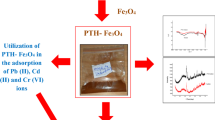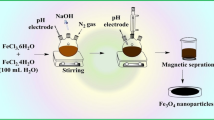Abstract
Fe3O4 nanoparticles were surface modified with Prussian blue (PB) and the nanoparticles were used for the removal of cesium (Cs) ion. The attachment of PB with the Fe3O4 and their morphology were explained based on the studies by transmission electron microscope and BET measurements. The Cs ion adsorption studies have shown that the Cs removal efficiency reached maximum within 120 min. The adsorption kinetics studies using Lagergren pseudo-first-order kinetic model suggest the values of the amount of metal ion adsorbed at equilibrium (q e) and adsorption rate constant (k 1) as 22 mg/g and 0.015 min−1, respectively. The capture efficiency of the prepared nanoparticles was studied by varying the flow channel diameter, applied magnetic field, and the fluid flow velocity. The study suggests that PB-Fe3O4 nanoparticles could be used for the detoxification of Cs where the flow velocity is in the range of few tens of cm/s.






Similar content being viewed by others
References
Avery SV (1996) Fate of caesium in the environment: distribution between the abi-otic and biotic components of aquatic and terrestrial ecosystems. J Environ Radioact 30:139–171
Faustino PJ, Yang Y, Progar JJ, Brownell CR, Sadrieh N, May JC, Leutzinger E et al (2008) Quantitative determination of cesium binding to ferrichexacyanoferrate: Prussian blue. J Pharm Biomed 47:114–125
Pearce J (1994) Studies of any toxicological effects of Prussian blue compounds in mammals—A review. Food Chem Toxicol 32:577–582
Hu M, Furukawa S, Ohtani R, Sukegawa H, Nemoto Y, Reboul J, Kitagawa S, Yamauchi Y (2012) Synthesis of Prussian blue nanoparticles with a hollow interior by controlled chemical etching. Angew Chem Int Ed 51:984–988
Lian HY, Hu M, Liu CH, Yamauchi Y, Wu KCW (2012) Highly biocompatible, hollow coordination polymer nanoparticles as cisplatin carriers for efficient intracellular drug delivery. Chem Commun 48:5151–5153
Hu M, Belik A, Imura M, Mibu K, Tsujimoto Y, Yamauchi Y (2012) Synthesis of superparamagnetic nanoporous iron oxide particles with hollow interiors by using Prussian blue coordination polymers. Chem Mater 24:2698–2707
Chiang YD, Hu M, Kamachi Y, Ishihara S, Takai K, Tsujimoto Y, Ariga K, Wu KCW, Yamauchi Y (2013) Rational design and synthesis of cyano-bridged coordination polymers with precise control of particle size from 20 to 500 nm. Eur J Inorg Chem 2013:3141–3145
Hu M, Ishihara S, Ariga K, Imura M, Yamauchi Y (2013) Kinetically controlled crystallization for synthesis of monodispersed coordination polymer nanocubes and their self-assembly to periodic arrangements. Chem Eur J 19:1882–1885
Hu M, Belik AA, Imura M, Yamauchi Y (2013) Tailored design of multiple nanoarchitectures in metal-cyanide hybrid coordination polymers. J Am Chem Soc 135:384–391
Hu M, Yamauchi Y (2011) Synthesis of a titanium-containing Prussian-blue analogue with a well-defined cube structure and its thermal conversion into a nanoporous titanium–iron-based oxide. Chem Asian J 6:2282–2286
Thompson DF, Church CO (2001) Prussian blue for treatment of radiocesium poisoning. Pharmacotherapy 21:1364–1367
Barton GB, Hepworth JL, McClanahan ED, Moore RL, VanTuyl HH (1958) Chemical processing wastes, recovering fission products. Ind Eng Chem 50:212–216
Ishizaki M, Akiba S, Ohtani A, Hoshi Y, Ono K, Matsuba M, Togashi T, Kananizuka K et al (2013) Proton-exchange mechanism of specific Cs+ adsorption via lattice defect sites of Prussian blue filled with coordination and crystallization water molecules. Dalton Trans 42:16049–16055
Namiki Y, Namiki T, Ishii Y, Koido S, Nagase Y, Tsubota A, Tada N, Kitamoto Y (2012) Inorganic-organic magnetic nanocomposites for use in preventive medicine: a rapid and reliable elimination system for cesium. Pharm Res 29:1404–1418
Sangvanich T, Sukwarotwat V, Wiacek RJ, Grudzien RM, Fryxell GE, Addleman RS, Timchalk C, Yantasee W (2010) Selective capture of cesium and thallium from natural waters and simulated wastes with copper ferrocyanide functionalized mesoporous silica. J Hazard Mater 182:225–231
Delchet C, Tokarev A, Dumail X, Toquer G, Barre Y, Guari Y, Guerin C, Larionova J, Grandjean A (2012) Extraction of radioactive cesium using innovative functionalized porous materials. RSC Adv 2:5707–5716
Lin Y, Fryxell GE, Wu H, Englhard M (2001) Selective sorption of cesium using self-assembled monolayers on mesoporous supports. Environ Sci Technol 35:3962–3966
Parab H, Sudersanan M (2010) Engineering a lignocellulosic biosorbent–Coir pith for removal of cesium from aqueous solutions: equilibrium and kinetic studies. Water Res 44:854–860
Chang CY, Chau LK, Hu WP, Wang CY, Liao JH (2008) Nickel hexacyanoferrate multilayers on functionalized mesoporous silica supports for selective sorption and sensing of cesium. Microporous Mesoporous Mat 109:505–512
Rassat SD, Sukamto JH, Orth RJ, Lilga MA, Hallen RT (1999) Development of an electrically switched ion exchange process for selective ion separations. Sep Purif Technol 15:207–222
Lilga MA, Orth RJ, Sukamto JPH, Rassat SD, Genders JD, Gopal R (2001) Cesium separation using electrically switched ion exchange. Sep Purif Technol 24:451–466
Chen BW, Xia XH (2007) Highly stable nickel hexacyanoferrate nanotubes for electrically switched ion exchange. Adv Funct Mater 17:2943–2948
Lilga MA, Orth RJ, Sukamto JPH, Haight SM, Schwartz DT (1997) Metal ion separations using electrically switched ion exchange. Sep Purif Technol 11:147–158
Chen R, Tanaka H, Kawamoto T, Asai M, Fukushima C, Kurihara M, Watanabe M, Arisaka M, Nankawa T (2012) Preparation of a film of copper hexacyanoferrate nanoparticles for electrochemical removal of cesium from radioactive wastewater. Electrochem Commun 25:23–25
Prout WE, Russell ER, Grob HJ (1965) Ion exchange absorption of cesium by potassium hexacyanocobalt (II) ferrate (II). J Inorg Nucl Chem 27:473–479
Chen H, Kaminski MD, Rosengart AJ (2008) 2D modeling and preliminary in vitro investigation of a prototype high gradient magnetic separator for biomedical applications. Med Eng Phys 30:1–8
Falkenhagen D, Brandl M, Hartmann J, Kellner KH, Posnicek T, Weber V (2006) Fluidized bed adsorbent systems for extracorporeal liver support. Ther Apher Dial 10:154–159
Brandl M, Mayer M, Hartmann J, Posnicek T, Fabian C, Falkenhagen D (2010) Theoretical analysis of ferromagnetic microparticles in streaming liquid under the influence of external magnetic forces. J Magn Magn Mater 322:2454–2464
Berry CC, Curtis ASG (2003) Functionalisation of magnetic nanoparticles for applications in biomedicine. J Phys D 36:R198–R206
Iacob G, Rotariu O, Strachan NJC, Häfeli UO (2004) Magnetizable needles and wires-modeling an efficient way to target magnetic microspheres in vivo. Biorheology 41:599–612
Ritter JA, Ebner AD, Daniel KD, Stewart KL (2004) Application of high gradient magnetic separation principles to magnetic drug targeting. J Magn Magn Mater 280:184–201
Avilės MO, Ebner AD, Chen H, Rosengart AJ, Kaminski MD, Ritter JA (2005) Theoretical analysis of a transdermal ferromagnetic implant for retention of magnetic drug carrier particles. J Magn Magn Mater 293:605–615
Chen H, Ebner AD, Kaminski MD, Rosengart AJ, Ritter JA (2005) Analysis of magnetic drug carrier particle capture by a magnetizable intravascular stent—2: parametric study with multi-wire two-dimensional model. J Magn Magn Mater 293:616–632
Tang SCN and Lo (2013) IMC Magnetic nanoparticles: essential factors for sustainable environmental applications. Water Res 47:2613–2632
Arun T, Prakash K, Justin Joseyphus R (2013) Synthesis and magnetic properties of prussian blue modified Fe nanoparticles. J Magn Magn Mater 345:100–105
Arun T, Prakash K, Kuppusamy R, Justin Joseyphus R (2013) Magnetic properties of Prussian blue modified Fe3O4 nanocubes. J Phys Chem Solids 74:1761–1768
Kaye SS, Long JR (2007) The role of vacancies in the hydrogen storage properties of Prussian blue analogues. Catal Today 120:311–316
Kaye SS, Long JR (2005) Hydrogen storage in the dehydrated Prussian blue analogues M3[Co(CN)6]2 (M = Mn, Fe Co, Ni, Cu, Zn). J Am Chem Soc 127:6506–6507
Ming H, Torad NLK, Chiang YD, Wu KCW, Yamauchi Y (2012) Size-and shape-controlled synthesis of Prussian blue nanoparticles by a polyvinylpyrrolidone-assisted crystallization process. Cryst Eng Comm 14:3387–3396
Song C, Du JP, Zhao JH, Feng SA, Du GX, Zhu ZP (2009) Hierarchical porous core– shell carbon nanoparticles. Chem Mater 21:1524–1530
Cho W, Lee HJ, Oh M (2008) Growth-controlled formation of porous coordination polymer particles. J Am Chem Soc 130:16943–16946
Kobler J, Bein T (2008) Porous thin films of functionalized mesoporous silica nanoparticles. ACS Nano 2:2324–2330
Sing KSW, Everett DH, Haul RAW, Moscou L, Pierotti RA, Rouquerol J, Siemieniewska T (1985) Reporting physisorption data for gas/solid systems with special reference to the determination of surface area and porosity. Pure Appl Chem 57:603–619
Kruk M, Jaroniec M (2001) Gas adsorption characterization of ordered organic-inorganic nanocomposite materials. Chem Mater 13:3169–3183
Kim JO, Lee SM, Jeon C (2014) Adsorption characteristics of sericite for cesium ions from an aqueous solution. Chem Eng Res Des. doi:10.1016/j.cherd.2013.07.020
Lv K, Xiong LP, Luo YM (2013) Ion exchange properties of cesium ion sieve based on zirconium molybdopyrophosphate. Colloids Surf A 433:37–46
Torad NL, Hu M, Imura M, Naito M, Yamauchi Y (2012) Large Cs adsorption capability of nanostructured Prussian blue particles with high accessible surface areas. J Mater Chem 22:18261–18267
Lagergren S (1898) Zurtheorie der sogenannten adsorption gelösterstoffe. K Sven Vetenskapsakad Handl 24:1–39
Ho YS, McKay G (1999) Pseudo-second-order model for sorption processes. Process Biochem 34:451–465
Thammawong C, Opaprakasit P, Tangboriboonrat P, Sreearunothai P (2013) Prussian blue modified magnetic oxide nanoparticles for removal of cesium from contaminated environment. J Nanopart Res 15:1689–1699
Furlani EP, Ng KC (2006) Analytical model of magnetic nanoparticle transport and capture in the microvasculature. Phys Rev 73:061919-1–06191910
Tang W, Su Y, Li Q, Gao S, Shang JK (2013) Superparamagnetic magnesium ferrite nanoadsorbent for effective arsenic (III, V) removal and easy magnetic separation. Water Res 47:3624–3634
Shan C, Tong M (2013) Efficient removal of trace arsenite through oxidation and adsorption by magnetic nanoparticles modified with Fe–Mn binary oxide. Water Res 47:3411–3421
Acknowledgements
The authors acknowledge the Department of Science and Technology (DST), Govt. of India for financial assistance through (SR/FTP/ETA-11/2008), the FIST program (SR/FST/PSI-117/2007), and the nanomission project (SR/NM/NS-27/2008). The authors acknowledge Dr. S. Velmathi, Department of Chemistry, National Institute of Technology for the BET measurement.
Author information
Authors and Affiliations
Corresponding author
Electronic supplementary material
Below is the link to the electronic supplementary material.
Rights and permissions
About this article
Cite this article
Arun, T., Justin Joseyphus, R. Prussian blue modified Fe3O4 nanoparticles for Cs detoxification. J Mater Sci 49, 7014–7022 (2014). https://doi.org/10.1007/s10853-014-8406-x
Received:
Accepted:
Published:
Issue Date:
DOI: https://doi.org/10.1007/s10853-014-8406-x




